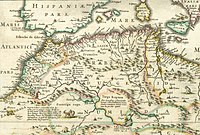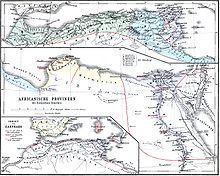Numidia
Kingdom of Numidia | |||||||||||
|---|---|---|---|---|---|---|---|---|---|---|---|
| 202 BC–46 BC | |||||||||||
 Map of Numidia 230 BC | |||||||||||
| Capital | Cirta | ||||||||||
| Common languages | Numidian, Latin, Punic [1] | ||||||||||
| Government | Monarchy | ||||||||||
| King | |||||||||||
• 202–148 BC | Masinissa | ||||||||||
• 60–46 BC | Juba I of Numidia | ||||||||||
| Historical era | Antiquity | ||||||||||
• Established | 202 BC | ||||||||||
• Annexed by the Roman Republic | 46 BC | ||||||||||
| |||||||||||
| Today part of | |||||||||||
Numidia (202 BC – 46 BC) was an ancient kingdom of the Numidians in what is now Algeria and a smaller part of Tunisia, in North Africa. Numidia was originally divided between Massylii in the east and Masaesyli in the west. During the Second Punic War (218-201 BC), Massinissa, king of the Massylii, defeated Syphax of the Masaesyli to unify Numidia into one kingdom. The kingdom began as a sovereign state and later alternated between being a Roman province and a Roman client state. It was bordered by the kingdoms of Mauretania (modern-day Morocco) to the west, the Roman province of Africa (modern-day Tunisia) to the east, the Mediterranean Sea to the north, and the Sahara Desert to the south. It is considered to be the first major state in the history of Algeria and the Berber world.
History

Independent Numidia
The Greek historians referred to these peoples as "Νομάδες" (i.e. Nomads), which by Latin interpretation became "Numidae" (but cf. also the correct use of Nomades).[2] The name appears first in Polybius (second century BC) to indicate the peoples and territory west of Carthage including the entire north of Algeria as far as the river Mulucha (Muluya), about 160 kilometres (100 mi) west of Oran.[3]
The Numidians were conceived of two great tribal groups: the Massylii in eastern Numidia, and the Masaesyli in the west. During the first part of the Second Punic War, the eastern Massylii, under their king Gala, were allied with Carthage (a 'Punic', i.e. Phoenician, Semitic, mercantile sea empire called after its capital in present Tunisia), while the western Masaesyli, under king Syphax, were allied with Rome. However, in 206 BC, the new king of the eastern Massylii, Masinissa, allied himself with Rome, and Syphax of the Masaesyli switched his allegiance to the Carthaginian side. At the end of the war, the victorious Romans gave all of Numidia to Masinissa of the Massylii. At the time of his death in 148 BC, Masinissa's territory extended from Mauretania to the boundary of the Carthaginian territory, and also southeast as far as Cyrenaica, so that Numidia entirely surrounded Carthage (Appian, Punica, 106) except towards the sea.
After the death of the long-lived Masinissa around 148 BC, he was succeeded by his son Micipsa. When Micipsa died in 118, he was succeeded jointly by his two sons Hiempsal I and Adherbal and Masinissa's illegitimate grandson, Jugurtha, of Ancient Libyan origin, who was very popular among the Numidians. Hiempsal and Jugurtha quarrelled immediately after the death of Micipsa. Jugurtha had Hiempsal killed, which led to open war with Adherbal.[citation needed]
War with Rome
| History of Algeria |
|---|
 |
By 112, Jugurtha resumed his war with Adherbal. He incurred the wrath of Rome in the process by killing some Roman businessmen who were aiding Adherbal. After a brief war with Rome, Jugurtha surrendered and received a highly favourable peace treaty, which raised suspicions of bribery once more. The local Roman commander was summoned to Rome to face corruption charges brought by his political rival Gaius Memmius. Jugurtha was also forced to come to Rome to testify against the Roman commander, where he was completely discredited once his violent and ruthless past became widely known, and after he had been suspected of murdering a Numidian rival.
War broke out between Numidia and the Roman Republic and several legions were dispatched to North Africa under the command of the Consul Quintus Caecilius Metellus Numidicus. The war dragged out into a long and seemingly endless campaign as the Romans tried to defeat Jugurtha decisively. Frustrated at the apparent lack of action, Metellus' lieutenant Gaius Marius returned to Rome to seek election as Consul. Marius was elected, and then returned to Numidia to take control of the war. He sent his Quaestor Lucius Cornelius Sulla to neighbouring Mauretania in order to eliminate their support for Jugurtha. With the help of Bocchus I of Mauretania, Sulla captured Jugurtha and brought the war to a conclusive end. Jugurtha was brought to Rome in chains and was placed in the Tullianum.[citation needed]
Jugurtha was executed by the Romans in 104 BC, after being paraded through the streets in Gaius Marius' Triumph.[citation needed]
Roman province

After the death of Jugurtha, western Numidia was added to the lands of Bocchus, king of Mauretania, while the remainder (excluding Cyrene and its locality) continued to be governed by native princes until the civil war between Caesar and Pompey. After Cato the Younger was defeated by Caesar, he committed suicide (46 BC) in Utica, and Numidia became briefly the province of Africa Nova until Augustus restored Juba II (son of Juba I) after the Battle of Actium.
Soon afterwards, in 25 BC, Juba was transferred to the throne of Mauretania, and Numidia was divided between Mauretania and the province of Africa Nova. Under Septimius Severus (193 AD), Numidia was separated from Africa Vetus, and governed by an imperial procurator. Under the new organization of the empire by Diocletian, Numidia was divided in two provinces: the north became Numidia Cirtensis, with capital at Cirta, while the south, which included the Aurès Mountains and was threatened by raids, became Numidia Militiana, "Military Numidia", with capital at the legionary base of Lambaesis. Subsequently however, Emperor Constantine the Great reunited the two provinces in a single one, administered from Cirta, which was now renamed Constantina (modern Constantine, Algeria) in his honour. Its governor was raised to the rank of consularis in 320, and the province remained one of the seven provinces of the diocese of Africa until the invasion of the Vandals in 428 AD, which began its slow decay, accompanied by desertification. It was restored to Roman rule after the Vandalic War, when it became part of the new praetorian prefecture of Africa.[citation needed]
Major cities
Numidia became highly Romanized and was studded with numerous towns. The chief towns of Roman Numidia were: in the north, Cirta or modern Constantine, the capital, with its port Russicada (Modern Skikda); and Hippo Regius (near Bône), well known as the see of St. Augustine. To the south in the interior military roads led to Theveste (Tebessa) and Lambaesis (Lambessa) with extensive Roman remains, connected by military roads with Cirta and Hippo, respectively.[4]
Lambaesis was the seat of the Legio III Augusta, and the most important strategic centre, commanding the passes of the Mons Aurasius, a mountain block that separated Numidia from the Gaetulian tribes of the desert, and which was gradually occupied in its whole extent by the Romans under the Empire. Including these towns, there were altogether twenty that are known to have received at one time or another the title and status of Roman colonies; and in the 5th century, the Notitia Dignitatum enumerates no fewer than 123 sees whose bishops assembled at Carthage in 479.
Episcopal sees
Ancient episcopal sees of Numidia listed in the Annuario Pontificio as titular sees:[5]
See also
- List of Kings of Numidia
- Numidians
- Numidian cavalry
- Roman Libya
- Africa (Roman province)
- Shawiya language
References
- ^ Jongeling. Karel; & Kerr, Robert M. (2005). Late Punic epigraphy: an introduction to the study of Neo-Punic and Latino-Punic inscriptions. Mohr Siebeck. p. 4. ISBN 3-16-148728-1.
{{cite book}}: CS1 maint: multiple names: authors list (link) - ^ Numida and Nomas
- ^ Numidia, Encyclopædia Britannica 1911
- ^ Detailed map of Roman Numidia
- ^ Annuario Pontificio 2013 (Libreria Editrice Vaticana, 2013, ISBN 978-88-209-9070-1), "Sedi titolari", pp. 819-1013
- This article incorporates text from a publication now in the public domain: Chisholm, Hugh, ed. (1911). Encyclopædia Britannica (11th ed.). Cambridge University Press.
{{cite encyclopedia}}: Missing or empty|title=(help)
External links
- Ancient Algeria
- History of Numidia
- History of Algeria
- Provinces of Roman North Africa
- Berber history
- States of Ancient Africa
- States and territories established in the 3rd century BC
- 3rd-century BC establishments in Africa
- 202 BC
- 200s BC establishments
- 1st-century BC disestablishments in the Roman Empire
- 1st-century BC disestablishments in Africa
